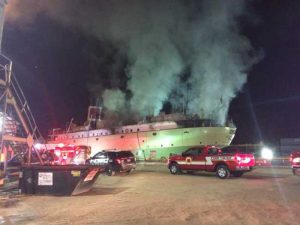
Ship caught fire in dry dock due to electrical fault
NOVEMBER 15, 2016 — A National Transportation Safety Board Report finds that the probable cause of a fire that broke out December 11, 2015 on a 1942-built Great Lakes steamship while in

NOVEMBER 15, 2016 — A National Transportation Safety Board Report finds that the probable cause of a fire that broke out December 11, 2015 on a 1942-built Great Lakes steamship while in
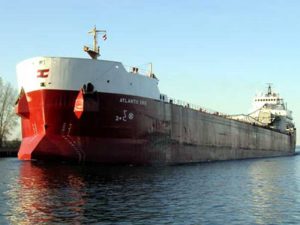
NOVEMBER 6, 2016 —Canada Steamship Lines reports that the self-unloading bulk carrier Spirit of Shpongle, formerly known as Atlantic Erie, left the Port of Montreal for the last time, November 4, bound
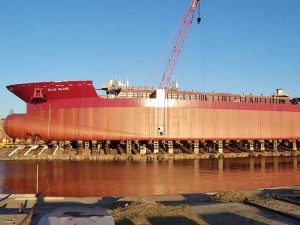
OCTOBER 4, 2016 — Eastern Shipbuilding’s Allanton, FL, shipyard has launched the Ellis Island, the barge component of the Articulated Tug & Barge (ATB) hopper dredge it has under construction for Great
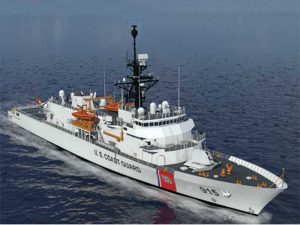
SEPTEMBER 21, 2016 — Quantic Engineering and Logistics Corporation, Panama City Beach, FL, reports it is Eastern Shipbuilding Group’s Integrated Logistics Support (ILS) subcontractor for the recently awarded USCG Offshore Patrol Cutter
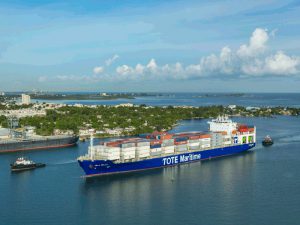
Leading shipowners and operators, gas suppliers, ports, class societies, and technologists gathered last month in London to announce a new cross-industry initiative aimed at accelerating the adoption of Liquefied Natural Gas (LNG) as a marine fuel. The initiative hopes to address the issues of LNG bunkering infrastructure, regulatory concerns, and the higher initial capital investment costs in building LNG-fueled vessels.
Called SEA/LNG, the initiative brings together participants from Carnival Corporation & plc, DNV GL, ENGIE, ENN, GE, GTT, Lloyd’s Register, Mitsubishi Corporation, NYK Line, Port of Rotterdam, Qatargas, Shell, TOTE Inc. and Wärtsilä.
The goal of the initiative explains TOTE Inc. Executive Vice President Peter Keller, who is serving as SEA\LNG’s Chairman, is to address “market barriers and help transform the use of LNG as a marine fuel into a global reality.”
When it comes to using LNG as a marine fuel, TOTE is all in. It’s committed about $500 million in capital investments to have its entire fleet to burn LNG. The U.S.-flag operator has built two 3,100 TEU LNG-fuelled containerships now in operation between the Port of Jacksonville, FL, and San Juan, PR, and is converting the two ORCA Class Roll-on/Roll-Off ships in its fleet to burn LNG. The first of those two is being converted at Singapore’s Keppel Shipyard this fall.
TOTE is not alone in adding dual-fuel and LNG-Ready tonnage to its oceangoing fleet in the U.S. Harvey Gulf International Marine, Crowley Maritime Corp., Matson Navigation, Kinder Morgan, and SEA VISTA/SEACOR all have vessels in operation or under construction that burn or could eventually burn LNG as a marine fuel. In all, there are 29 vessels that are designed or could be converted to burn LNG as shown in the accompanying table. This does not include inland and coastal vessels such as towboats or ferries.
The U.S. Maritime Administration, for example, is supporting the conversion of a towboat to burn LNG as fuel.
The use of LNG as a marine fuel has increased with Emission Control Areas (ECAs) coming into force in Northern Europe and North America under MARPOL Annex VI. LNG is relatively clean burning, containing virtually no sulfur content and it produces lower NOx and particulate matter in the combustion process than fuel oil and marine diesel oil.
A long-time, well-known proponent of LNG as a marine fuel, John Hatley, PE, Gas Initiatives Wärtsilä North America, sees gas as a compelling solution for box feeders, RO/RO vessels, ferries and cruise ships, product tankers, Great Lakes vessels, and ATBs on short coastal voyages that enter into ECAs.
LNG is therefore able to offer a fuel solution compliant with both current and anticipated future regulations.
The larger effect from Annex VI will come when the requirement to reduce sulfur content of marine fuels to 0.5% on a global basis effective 2020 or 2025 depending on the outcome of an IMO low sulfur fuel availability study to be completed in 2018. The issue for ship owners and operators is how to find alternatives to economically meet the low sulfur fuel mandate about to be imposed by MARPOL Annex VI.
However, while LNG is a competitive fuel relative to current alternatives, LNG infrastructure is needed in ports around the world to enable quick, safe and cost effective bunkering. In the U.S., the first LNG bunker transport barge with GTT Mark III Flex tank technology is under construction at Conrad Orange shipyard in Orange, TX, and expected to be delivered in early 2017. LNG bunkering infrastructure is far more advanced in Europe.
“Everybody is calling for alternatives to reduce environmental impacts says Philip Olivier, CEO of ENGIE Global LNG. “That’s why we have joined forces to actively promote LNG as a key fuel in maritime transport. LNG has the potential to take a 10% market share of global bunker demand by 2030. ENGIE will contribute to achieving this target.”
Tom Strang, Senior Vice President, Maritime Affairs, Carnival Corporation & plc, says, “By working together proactively across the whole marine LNG value chain we can make the transition to a lower emission marine sector a reality.”
Lauran Wetemans Shell’s general manager downstream LNG agrees. “To make the transition to LNG as a fuel happen it needs close collaboration with key players across the full value chain,” says, Wetemans. “SEA/LNG aims to promote the benefits and potential of LNG fuel, and create a level playing field for LNG with other fuels. It will complement the work being done by other organizations like the Society for Gas as a Marine Fuel.”
Leo Karistios, Gas Technology Lead, Lloyd’s Register, points out, “LNG fuelled shipping has mainly been for the visionaries and, until now, concentrated in specialist ship sectors: short sea shipping and ferries, mainly sailing between two fixed ports. We want to help drive the expansion of LNG as a marine fuel of choice, with not just more short sea and local ships burning gas, but also the deep sea trades.”
Timo Koponen, Vice President, Flow & Gas Solutions, Wärtsilä Marine Solutions, says his company will contribute “its vast experience and know-how in gas driven propulsion systems and the entire gas value chain” to the initiative. “By working together, we plan to overcome the challenges and speed the general acceptance of LNG. Having been a pioneer in the use of LNG as a marine fuel, and a developer of major technologies facilitating the adoption of LNG fuel, it is natural that Wärtsilä supports wholeheartedly the aims of the SEA/LNG coalition.”
Developing bulk carrier concept
Wärtsilä is also involved with an effort with class society ABS, Arista Shipping, Deltamarin, and GTT in the Project Forward joint development project (JDP) to develop a dry bulk carrier concept that employs LNG as fuel.
The goal is to develop a Kamsarmax bulk carrier design to be the first of this type suitable for worldwide services powered by LNG in compliance with the IMO’s Energy Efficiency Design Index 2025 standards, NOx Tier III and MARPOL Annex VI SOx emission levels. This landmark design will be the first LNG-fueled cargo ship capable of full-range operations.
“The long-term potential for LNG as a marine fuel is tremendous,” says ABS Vice President of Global Gas Solutions Patrick Janssens. “We see the near-term opportunities for larger vessels on fixed and known trade routes, but more opportunities will emerge as concepts mature and bunkering infrastructure expands. Environmental stewardship will continue to be a concern, and owners will be evaluating alternative fuel choices.”
“Project Forward represents a milestone for the shipping industry in bringing to the market a practical, achievable design for what are the workhorses of the shipping fleet,” says Arista Shipping Principal Alexander P. Panagopulos. “Our mission is to develop the next generation of energy efficient and environmentally friendly dry bulk cargo ships to be sustainable worldwide beyond 2030. It marks a number of ‘firsts’ and draws together the experience of a team of leaders in their field to make LNG powered shipping a reality on the high seas.”
Technical challenges in developing this design were considerable, as there is a need to carry a large volume of LNG (2,500 m3) – which corresponds to full-range operation and 40 days – in a type of ship where available space is limited and cargo space is at a premium.
ABS will provide Approval in Principle (AIP) for the concept, which is based on the highly optimized Deltamarin B.Delta 82 design, utilizing a GTT membrane LNG fuel tank. This design also could be applied to other bulk carrier sizes and serve as the basis for an LNG-fueled tanker. The concept features a Wärtsilä four-stroke, medium-speed engine without auxiliary generators, the first time this configuration has been applied to a vessel of this type, significantly simplifying the vessel’s engine room arrangement and contributing to lower capital expenditure.
Read more from our Green Technology & Sustainable Shipping section in our Digital Edition.
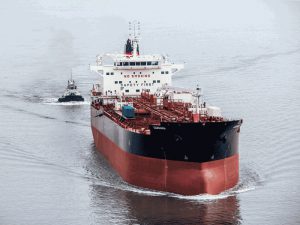
The total capacity of these vessels is just over 7 million deadweight tons (dwt), with a total current value of $4.5 billion (See Table 1: Value of U.S.-Built Shipping). Globally, the United States (as a shipbuilding nation) is ranked in 11th place (in terms of dwt) and a respectable sixth place behind South Korea, Japan, China, the Philippines, Germany, and Turkey in terms of the current value of the U.S. built fleet. Based on the volume of ships on the water, the most prolific U.S. shipbuilder has been NASSCO, San Diego, CA, a unit of General Dynamics. NASSCO also operates shipyards on the U.S. East Coast in Mayport, FL, and Norfolk, VA. As of mid-March, VesselsValue estimated the ships being built at NASSCO had values of around $900 million (this value excludes delivered ships). NASSCO recently launched the 53,700 dwt MR tanker Independence, which VesselsValue currently values at $133.45 million (this excludes a premium for the Jones Act). The Independence will be joined by two MR2 tankers on order at NASSCO for Seabulk Tankers. As of mid-March, NASSCO had four MR2 tankers on its order book for American Petroleum Tankers. 
The San Diego shipyard delivered two LNG-fuelled 3,100-TEU containerships, including the lead of the Marlin class, the Isla Bella, in November 2015 to Tote Maritime. The Isla Bella, along with its sister, Perla dela Caribe, are now operating between Jacksonville, FL, and San Juan, PR.
The only other U.S. shipyard with bulker, tanker, and gas carrier vessels currently on its order book is Philly Shipyard, Philadelphia, PA (formerly known as Aker Philadelphia Shipyard Inc.) Philly Shipyard has built product tankers, crude carriers, and containerships. The Philly Shipyard built fleet is currently valued at just over $1 billion. Its order book consists of eight 50,000 dwt MR tankers and this design has been classed by ABS as LNG Ready, which provides the owner with the flexibility to choose to convert the ship to dual fuel operation in the future.
In early May, Crowley Maritime Corporation christened the Louisiana, third of four LNG Ready product tankers at the Julia Street Cruise Terminal in New Orleans, LA.
Like its sisters, the 600 ft Louisiana is based on a proven design from Korea’s Hyundai Mipo Dockyards (HMD) design. It can carry crude oil or refined petroleum products, as well as other chemical products.
Construction management services were provided by Crowley’s marine solutions group, which provides oversight and management in shipyards across the country for Crowley and other third-party companies. Philly Shipyard also built the tankers Texas and Ohio for Crowley, and the fourth ship in the program is under construction with delivery planned for third quarter 2016.
“The christening underscores our continued commitment to building and operating innovative vessels that deliver the best possible service and efficiency for our customers who depend on us for safe and reliable transportation of petroleum products,” says Rob Grune, Senior Vice President and General Manager, Petroleum Services. “And, as is the case with its sister ships, we designed and built the Louisiana to have the capability to be converted to LNG propulsion in the future, increasing the likelihood of a long service life as new emissions regulations are developed in the years ahead.”
JONES ACT FLEET CONSIDERABLY OLDER THAN WORLD FLEET
It’s no secret that the U.S. Jones Act fleet is considerably older than the average age of the global, non-U.S.-built fleet. The current U.S.-built fleet has an average age of 33 years old versus 13 years old for the global fleet. The most recent ships produced by U.S. shipyards have been tankers and the average age of U.S.-built tankers is only five years older than the global fleet. However, there has been virtually no U.S. investment in bulkers (many of them are part of the Great Lakes fleet). The U.S.-built bulker fleet has an average age of 46 years old versus nine years old for the global fleet. Even a relatively modern ship type, such as containerships, the average age of the U.S.-built fleet is 32 years old, considerably older than the average of 11 years old for non-U.S.-built vessels.
TOP TEN U.S. SHIPOWNERS
According to VesselsValue, the Top Ten U.S. shipowners ranked by value control around half the capacity (48%) of the U.S. fleet (see Table 2. U.S. Shipowners Ranked by Fleet Value).
The Top Ten Shipowners are tanker companies or the tanker arms of oil majors. The current most valuable U.S.-operated fleet is that American Shipping Co., a Norwegian public company controlling a fleet of 10 MR2 tankers built by Philly Shipyard and leased out to OSG, which charters them out to Jones Act qualifying companies. VesselsValue estimates this fleet is worth $830 million. The second most valuable U.S. fleet belongs to new entrant American Petroleum Tankers, which is a subsidiary of Kinder Morgan Terminals, with its fleet operated by Crowley Maritime Corporation, Jacksonville, FL. This fleet will be supplemented by MR tankers currently on the order book of NASSCO. However, in the last 12 months, the U.S. order book has been very quiet, with no bulker, tankers or gas carriers ordered.
SALE AND PURCHASE ACTIVITY
If there is one area where U.S. shipping has been active, it’s been in the sale and purchase market. The dire dry bulk market is one of the driving forces behind Scorpio Bulker selling 25 vessels in the last 12 months (March 2015 to March 2016) for a combined value (at the time of sale) of $878 million (where the sale price is undisclosed, the VV Value the day of the sale is used). Altogether 88 vessels have been sold by U.S. owners for a combined value (where the sale price is undisclosed, the VV Value the day of the sale is used) of $3.4 billion (see Table 3: Sales by U.S. Owners).
Of course, under the Jones Act, U.S. companies cannot purchase foreign-built vessels to operate in Jones Act trade routes. This reduces the pool of potential purchases, which in the last 12 months (March 2015-March 2016) have been limited to eight vessels, including four MR tankers from Philly Shipyard purchased by Kinder Morgan for a reported $568 million (See Table 4: Purchases by U.S. Owners).
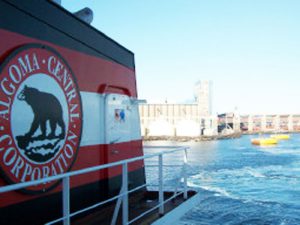
APRIL 25, 2016 — Cargotec subsidiary MacGregor has received an order for gravity self-unloading systems for two 29,800 dwt bulk carriers (lakers) from China’s Jiangsu Yangzijiang Shipbuilding Co. Ltd.. The vessels will

FEBRUARY 5, 2016—Marine propulsion specialist Schottel has opened a new sales office in the Quebec City, Quebec, area of Canada. Schottel Canada, Inc. will immediately serve the sales needs of current and
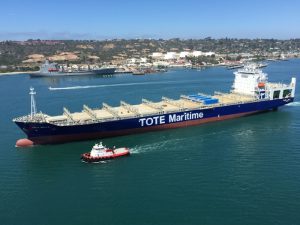
1. ISLA BELLA, WORLD’S FIRST LNG-FUELED CONTAINERSHIP (pictured above)
TOTE Maritime’s 3,100-TEU containership Isla Bella was due to set sail for San Juan, PR, on November 24, marking the first time a ship in a Jones Act liner service will burn Liquefied Natural Gas (LNG) as a marine fuel. When the 764-foot-long Isla Bella transited the Panama Canal back on October 30 on her way to the Port of Jacksonville, Panama Canal Administrator/CEO Jorge L. Quijano called her “a true engineering feat.”
Among the principal maritime stakeholders involved in the successful launch of the Isla Bella and her sister Perla del Caribe are: owner and operator TOTE, shipbuilder General Dynamics NASSCO, designer DSEC (Daewoo Shipbuilding and Marine Engineering’s ship design arm), engine licensee MAN Diesel & Turbo, classification society ABS, and regulator U.S. Coast Guard.
The two Marlin Class containerships were contracted by TOTE in December 2012 and are being built at a total cost of about $375 million.
The 764-ft Isla Bella is equipped with the world’s first dual-fuel slow-speed engine, an 8L70ME-GI built by Korea’s Doosan Engine, under license from MAN Diesel & Turbo. With a 3,100 TEU capacity, the LNG-powered Isla Bella reduces NOx emissions by 98 percent, SOx emissions by 97 percent and CO2 emissions by 76 percent. The technology makes the ship one of the world’s most environmentally friendly containerships afloat.
During LNG will allow the Marlin Class Isla Bella to be fully compliant with strict emissions regulations while operating in both the North American Emissions Control Area and the U.S. Caribbean ECA.
At the time of her delivery, Kevin Graney, Vice President and General Manager of General Dynamics NASSCO, said, “Successfully building and delivering the world’s first LNG-powered containership here in the United States for coastwise service demonstrates that commercial shipbuilders, and owners and operators, are leading the world in the introduction of cutting-edge, green technology in support of the Jones Act.”
The moment is bittersweet for TOTE as it unfolds within the shadow of the tragic loss of the SS El Faro with all hands aboard during Hurricane Joaquin on October 1. The ship’s crew of 28 and five Polish nationals onboard were lost. The U.S. Navy, working with the National Transportation Safety Board (NTSB), has located the ship in waters 15,000 feet deep near the Crooked Island in the Bahamas.
The Isla Bella will be joined by the Perla del Caribe in Puerto Rico cargo service in the first quarter of 2016.
2. OHIO, LNG-READY PRODUCT TANKER
The 330,000 bbl Ohio was became the first product tanker to be built with the future consideration for the future use of LNG as fuel when it was delivered earlier this year to Crowley Maritime Corp. by Aker Philadelphia Shipyard, Philadelphia, PA.
 The Ohio received American Bureau of Shipping’s (ABS) LNG-Ready Level 1 approval, meaning Crowley has the option to convert the tanker to Liquefied Natural Gas (LNG) propulsion in the future.
The Ohio received American Bureau of Shipping’s (ABS) LNG-Ready Level 1 approval, meaning Crowley has the option to convert the tanker to Liquefied Natural Gas (LNG) propulsion in the future.
The Ohio along with her three ships being built at Aker Philadelphia are based on a proven Hyundai Mipo Dockyards (HMD) design which incorporates numerous fuel efficiency features, flexible cargo capability, and a slow-speed diesel engine built under license from MAN Diesel & Turbo. The 600 feet long Ohio is capable of carrying crude oil or refined petroleum products.
Crowley’s Seattle-based, naval architecture and marine engineering subsidiary Jensen Maritime is providing construction management services for the product tankers. Jensen now has an on-site office and personnel at the Philadelphia shipyard to ensure strong working relationships with shipyard staff and a seamless construction and delivery program.
“We are excited to offer our customers cutting-edge technology available in these new tankers, which not only embraces operational excellence and top safety, but also offers the potential to be powered by environmentally friendly LNG in the future,” said Crowley’s Rob Grune, senior vice president and general manager, petroleum and chemical transportation. “Adding these new Jones Act tankers to our fleet allows us to continue providing our customers with diverse and modern equipment to transport their petroleum and chemical products in a safe and reliable manner.”
3. NEW MINI TANKER FOR NY HARBOR
Blount Boats, Inc., Warren, RI, delivered the Chandra B, a new mini-tanker for American Petroleum & Transport, Inc., Miller Place, NY. The 79 ft by 23 ft, double-hull bunkering tanker operates in New York Harbor and New Jersey supplying fuel to ferries, dinner boats, dredges, and other vessels.
 Propulsion power for the tanker is supplied by two EPA Tier 3-compliant Cummins Model QSL9, six-cylinder diesel engines rated at 330 hp at 1,800 rev/min with ZF Model W325 marine hydraulic gears that will have 4.91:1 reduction ratio. The self-propelled Chandra B is equipped with a 50 hp Wesmar hydraulic bow thruster, providing it with enhanced maneuverability.
Propulsion power for the tanker is supplied by two EPA Tier 3-compliant Cummins Model QSL9, six-cylinder diesel engines rated at 330 hp at 1,800 rev/min with ZF Model W325 marine hydraulic gears that will have 4.91:1 reduction ratio. The self-propelled Chandra B is equipped with a 50 hp Wesmar hydraulic bow thruster, providing it with enhanced maneuverability.
Designed by Farrell & Norton Naval Architects, Newcastle, ME, the Chandra B is built to USCG Subchapter “D” specifications and is less than 100 gross tons. Farrell & Norton also designed one of the tank barges in American Petroleum & Transport’s fleet. The double-hull Chandra B will replace the 1979-built single hull Capt. Log in American Petroleum & Transport’s fleet.
American Petroleum & Transport (APT) has had to retire all of its single-hull tankers because of OPA 90 regulations.
APT vessels crisscross New York Harbor delivering ultra low sulfur diesel to clients such as Circle Line, New York Water Taxi, Great Lakes Dredge & Dock, and Sterling Equipment, as well as for the auxiliary engines of larger ships. The Chandra B has cargo fuel tankage is designed to hold a capacity of 56,450 gallons.
4. SAKIGAKE, JAPAN’S FIRST LNG-POWERED TUG
This past year, NYK took delivery of Sakigake, Japan’s first LNG fueled tug. Built at NYK’s wholly owned subsidiary Keihin Dock Co’s Oppama shipyard, the 37.2 m x 10.2 m Sakigake is operated by Wing Maritime Service Corporation, mainly in the ports of Yokohama and Kawasaki. Wing Maritime also operates the hybrid tug Tsubasa.
 The Sakigake is equipped with two Niigata 6L28AHX-DF dual-fuel engines, each developing 1,618 kW. Propulsion is supplied by two Niigata Z-Pellers.
The Sakigake is equipped with two Niigata 6L28AHX-DF dual-fuel engines, each developing 1,618 kW. Propulsion is supplied by two Niigata Z-Pellers.
The DF engines can burn either LNG or diesel oil. The environmental advantages of operating on LNG as compared with conventionally powered tugs that use marine diesel oil is Sakigake emits about 30 percent less CO2, 80 percent less NOx, and no SOx.
While the project posed several challenges—the relatively small size and limited amount of space on the tug, and the large variation in engine power—Keihin Dock was able to achieve the desired level of environmental performance while maintaining the same hull form and steering performance of existing tugs. Keihin Dock worked closely with both Niigata Power Systems and Air Water Plant & Engineering Inc. to develop equipment for supplying LNG.
The project was supported by subsidies from Japan’s Ministry of Economy, Trade and Industry and the Ministry of Land, Infrastructure and Transport. ClassNK also provided joint research support.
5. JS INEOS INSIGHT, FIRST ETHANE-POWERED SHIP
Emblazoned on the JS Ineos Insight’s hull is the phrase, “Shale Gas for Manufacturing.” Built specifically to transport shale gas from the U.S. to Europe, the JS Ineos Insight is the first of eight 180m x 26.6m ethane gas carriers built by China’s Sinopacific for Denmark’s Evergas.
 Named on July 14, the JS Ineos Insight can not only carry ethane, LPG or LNG, but can also burn ethane, LNG and conventional diesel in its two Wartsila 50DF dual fuel engines.
Named on July 14, the JS Ineos Insight can not only carry ethane, LPG or LNG, but can also burn ethane, LNG and conventional diesel in its two Wartsila 50DF dual fuel engines.
The eight Ineos ships will transport over 800,000 tons of ethane gas at -90°C per annum across the Atlantic from the U.S. to Norway and Scotland.
Classed by Bureau Veritas, the Dragon vessels were originally designed as dual-fuel LNG/diesel-powered vessels, with two 1,000 m3 LNG tanks on deck powering two Wärtsilä 6L20 DF main engines with a total output of 2,112 kW and two shaft generators with a total output of 3,600 kW power. The vessels will initially transport ethane from the U.S, to the U.K. Ineos refineries, the ability to also burn ethane was added to allow use of the cargo gas as fuel.
At the christening of the JS Ineos Insight and the JS Ineos Ingenuity, Ineos Chairman Jim Ratcliffe says, “Today is a landmark day for both Ineos and Europe. We have seen how U.S. shale gas revolutionized U.S. manufacturing and we believe these huge ships will help do the same for Europe. Ineos together with Evergas has commissioned eight brand new ships, accessed hundreds of miles of new pipeline and built two enormous terminals to get U.S. Shale gas to Europe. The scale of the whole project is truly breathtaking.”
According to Bureau Veritas Business Development Manager Martial Claudepierre, the ability to burn ethane and LNG as fuel in the Dragon Class ships “is a major step forward in the use of clean fuels.” He says that BV worked with Evergas and the Danish Maritime Authority to verify and ensure that the use of ethane is at least as safe as required by the IGC and will not impair the engine compliance with MARPOL Annex VI.
According to Claudepierre, using ethane required extra engine room ventilation and additional gas detection, plus modifications to the main engines including a lower compression ratio, different turbocharger nozzles and de-rating of the engine to cope with the lower knocking resistance of ethane. “But,” he says, “The gains in not carrying an additional fuel and in environmental performance from being able to burn clean fuel throughout the voyage are significant.”
6. MARJORIE C, NEW JONES ACT CONRO
Capable of carrying up to 1,200 cars and 1,400 TEU of containers, the Combination Container and Roll-on/Roll-Off (ConRO) vessel Marjorie C entered Jones Act service this year between the U.S. West Coast and Hawaii.
 Built by VT Halter Marine, Pascagoula, MS, the Marjorie C was engineered from a proven design by Grimaldi at Croatia’s Uljanik Shipyard. The 692 ft x 106 ft ConRO has a draft of 31 ft, deadweight of 21,132.5 metric tons, with nine decks. It has a stern ramp capacity of 350 metric tons. The ship has a service speed of 21.5 knots.
Built by VT Halter Marine, Pascagoula, MS, the Marjorie C was engineered from a proven design by Grimaldi at Croatia’s Uljanik Shipyard. The 692 ft x 106 ft ConRO has a draft of 31 ft, deadweight of 21,132.5 metric tons, with nine decks. It has a stern ramp capacity of 350 metric tons. The ship has a service speed of 21.5 knots.
The vessel’s design incorporates the highest level of operating efficiencies as well as reduced environmental impacts. The sister vessel, Jean Anne, was Pasha Hawaii’s first Jones Act vessel and has been serving the Hawaii/Mainland trade since March 2005. The Marjorie C entered into service this past May.
The ship is named in honor of Pasha Hawaii’s President and CEO George Pasha, IV’s grandmother, Marjorie Catherine Ryan.
“After more than three and a half years of planning and construction, we are pleased to unveil a ship that has been designed to not only accommodate the varying needs of our customers, but a vessel that minimizes our carbon footprint through extensive fuel consumption efficiencies and other green technologies,” said Pasha Hawaii’s President and CEO, George Pasha, IV. “With the addition of the Marjorie C we can now offer customers increased service and capacity between the West Coast and Hawaii trade lane on vessels providing superior reliability and cargo protection.”
7. NEIL ARMSTRONG, FIRST OF NEW CLASS OF RESEARCH VESSELS
This past Halloween, the first-of-class oceanographic research vessel R/V Neil Armstrong (AGOR 27) set sail from Dakota Creek Industries, Anacortes, WA, to San Francisco, CA, on its inaugural voyage. As we went to press, the Neil Armstong was waiting its turn to pass through the Panama Canal on its way north to the Woods Hole Oceanographic Institute in Woods Hole, MA. The ship will be operated by the Woods Hole Oceanographic Institution under a charter party agreement with Office of Naval Research (ONR).
 Designed by Guido Perla & Associates, Inc., Seattle, WA and owned by the U.S. Navy, Neil Armstrong is 238 ft x 50 ft with a depth of 22 ft and draft of 15 ft. The first of two research vessels, the Neil Armstrong has four main 1,400 kW diesel generators, two 876 kW propulsion motors, and two controllable pitch propellers. The ship has a sustained speed of 12 knots and maximum speed of 12.8 knots.
Designed by Guido Perla & Associates, Inc., Seattle, WA and owned by the U.S. Navy, Neil Armstrong is 238 ft x 50 ft with a depth of 22 ft and draft of 15 ft. The first of two research vessels, the Neil Armstrong has four main 1,400 kW diesel generators, two 876 kW propulsion motors, and two controllable pitch propellers. The ship has a sustained speed of 12 knots and maximum speed of 12.8 knots.
The ship was classed by ABS Under 90 meter rules A1, Circle E, AMS, ACCU, NIBS, Ice Class D0, UWILD, 46 CFR Subchapter U, SOLAS (Oceanographic Vessels), MARPOL.
The Neil Armstrong’s sister vessel, the R/V Sally Ride (AGOR 28), is also under construction at Dakota Creek Industries.
During acceptance trials, Mike Kosar, Program Manager for the Support Ships, Boats and Craft office within the Program Executive Office (PEO), Ships, says, “The results of these tests and the outstanding fit, finish and quality of the vessel, stand as a testament to the preparation and effort of our entire shipbuilding team. It reflects the exceptionalism of AGOR 27’s namesake, Neil Armstrong.”
Neil Armstrong Class AGORS incorporate the latest technologies, including high-efficiency diesel engines, emissions controls for stack gasses, and new information technology tools both for monitoring shipboard systems and for communicating with the world. These ships will provide scientists with the tools and capabilities to support ongoing research including in the Atlantic, western Pacific and Indian Ocean regions across a wide variety of missions.
The lab areas include the main lab of 1,023 ft2, the wet area of 398 ft2, computer area of 311 ft2, and staging area bay of 303 ft2.
Neil Armstrong will be capable of assisting with integrated, interdisciplinary, general purpose oceanographic research in coastal and deep ocean areas. The vessel will operate with a crew of 20 with accommodations for 24 scientists.
8. BARZAN, FIRST OF NEW CLASS OF GAS READY BOXSHIPS
Recently named in a ceremony at shipbuilder Hyundai Samho Heavy Industries’ Mokpo, South Korea, shipyard, Barzan is the first in a series of six 18,800 TEU containerships ordered by Dubai headquartered United Arab Shipping Company (UASC). It is the first vessel to receive classification society DNV GL’s new GAS READY notation. Her five sister ships and eleven 15,000 TEU vessels of UASC’s newest eco-ship generation, will also receive the notation.
 The ships have been designed and constructed to enable a quick and cost efficient retrofit to LNG fueling at a later stage. The GAS READY notation, with nominators (D, S, MEc, AEi) demonstrates that the vessel is in compliance with the gas fueled notation rules, that structural reinforcements to support the fuel containment system (LNG tank) have been verified (S), that the main engines installed can be converted to dual fuel (MEc ) and that the auxiliary engines installed can be operated on gas (AEi).
The ships have been designed and constructed to enable a quick and cost efficient retrofit to LNG fueling at a later stage. The GAS READY notation, with nominators (D, S, MEc, AEi) demonstrates that the vessel is in compliance with the gas fueled notation rules, that structural reinforcements to support the fuel containment system (LNG tank) have been verified (S), that the main engines installed can be converted to dual fuel (MEc ) and that the auxiliary engines installed can be operated on gas (AEi).
“We believe that this vessel, as well as the rest of the vessels in our new building program, demonstrates our commitment to technical innovation and eco-effectiveness,” says Jørn Hinge, President and CEO of UASC. “For UASC, achieving optimum efficiency levels is not a single initiative or project, it is a strategy and an ongoing commitment, and we will continue to work with DNV GL on the remaining newbuild vessels that have the lowest levels of CO2 output in their class.”
As well as being LNG ready, Barzan and her sister vessels incorporate several innovative energy saving methods, including a Siemens’ Siship SGM environmentally friendly drive and power generation system.
The Waste Heat Recovery System (WHRS) converts thermal energy from the exhaust gas from the main engines into electrical power to maximize the efficiency of the system.
The Barzan was expected to have an EEDI (Energy Efficiency Design Index) value that is close to 50 per cent less than the 2025 limit set by IMO, with a CO2 output per TEU that is more than 60 per cent lower than a 13,500 TEU vessel delivered just three years ago.
Barzan has been constructed to DNV GL class rules with the notations: 1A1 Container Carrier DG-P Shore Power E0 NAUT-OC HMON (A1,C1,G4) CLEAN BWM-T BIS TMON NAUTICUS (Newbuilding) GAS READY (D, S, MEc, AEi).
9. CROWN POINT, NEW GENERATION GREEN TUG
Tidewater Transportation and Terminals, Vancouver, WA, recently took delivery of the Crown Point, the first in a series of three 102 ft x 38 ft towboats being built at Vigor Industrial in Portland, OR.
 The three towboats are the first new vessels to be built for the Tidewater fleet in 30 years, and are critical for the company to meet the anticipated rising customer demand on the Columbia-Snake River system. “The launching of the Crown Point, and the forthcoming Granite Point and Ryan Point vessels, marks an important step for Tidewater,” says Marc Schwartz, Maintenance & Engineering Manager at Tidewater. The vessels will strengthen our fleet, as well as reinforce Tidewater’s commitment to our customers, community, and environment.”
The three towboats are the first new vessels to be built for the Tidewater fleet in 30 years, and are critical for the company to meet the anticipated rising customer demand on the Columbia-Snake River system. “The launching of the Crown Point, and the forthcoming Granite Point and Ryan Point vessels, marks an important step for Tidewater,” says Marc Schwartz, Maintenance & Engineering Manager at Tidewater. The vessels will strengthen our fleet, as well as reinforce Tidewater’s commitment to our customers, community, and environment.”
Tidewater operates the largest barge transportation and terminal network on the Columbia-Snake River system. The Crown Point joins the company’s current fleet of 16 vessels and 160 barges. Tidewater transports a wide range of cargo among a network of ports, terminals and grain elevators throughout the entire Columbia-Snake River system, which stretches some 465 miles of waterways. We also operate five strategically located terminals and five pipelines with key intermodal connections to railroads, highways and other pipelines.
Designed by CT Marine, Naval Architects and Marine Engineers of Edgecomb, ME, the Crown Point is an environmentally friendly tug with EPA Tier 3 compliant diesel engines that reduce air emissions and improve fuel efficiency. Main propulsion is supplied by two Caterpillar 3516C EPA Tier 3 certified diesel engines producing 2,240 bhp, each at 1,600 rev/min. The engines drive two 92 in. x 100 in. fixed pitch, stainless steel propellers through CT28 Kort Nozzles capable of a service speed of 8 knots. Operating in the Columbia River Gorge high winds, extreme currents and swells can be considered normal piloting conditions. That’s why the Crown Pount abd her sister towboats are fitted with an enhanced steering system using four steering and four flanking rudders was designed. The towboat has a wheelhouse with exceptional all-round visibility through full height windows, leading edge navigation and communications equipment, and enhanced accommodations for the captain and crew.
“During the last year and a half, a great deal of effort went into designing, engineering and building a towboat that would meet or exceed performance parameters,” explains Bruce Reed, Tidewater COO and Vice President. “With crew endurance being a priority, we employed Noise Control Engineers, Billerica, MA to develop a sound and vibration control package for the vessel. By incorporating Christie and Grey vibration control mounts and comprehensive acoustic insulation, noise levels register at less than 60 decibels in the accommodations during vessel operation.”
Other equipment onboard the Crown Point includes two C7.1, Tier 3 generators, rated at 480v, 200 kW at 1,800 rev/min. The generators are controlled through an automatic transfer system that ensures the vessel will recover from a generator power loss in less than 30 seconds. Deck machinery includes seven Patterson WWP 65E-7.5, 65-ton electric deck winches, with pilothouse remote operation and local push button control stations on the main deck. Each winch has Samson 1 3/8” Turbo 75 Synthetic Line.
In order to use the newest technology and minimize power usage, variable frequency drives were used in all major rotating machinery applications and LED lighting was employed in both interior and exterior lighting applications. The vessel is fitted with a Kidde NOVEC 1230 fire suppression system. Centralized fire detection and alarms cover both the machinery spaces and accommodations.
10. MULTRATUG 28, A HYBRID TUG
This past year, Netherlands-based towage and salvage specialist Multraship took delivery of Multratug 28, a Damen ASD 2810 Hybrid tug built at Damen Shipyards Galaţi, in Romania, as part of a fleet expansion program.
 Classed by Lloyd’s Register, the hybrid Multratug 28 is 28.67m x 10.43m, with a maximum draft of 4.9m. The propulsion system includes two MTU 16V4000M63R diesel engines with one MTU 12V 2000 M41B propulsion genset of 800 kvA, 440V-60Hz. The battery pack are two 120 kWh. Two Rolls Royce US205 azimuth thrusters provide propulsion. The tug has a bollard pull of 62 tons, diesel direct speed of 13 knots, diesel electric speed of 8 knots, and battery pack speed of 4 knots.
Classed by Lloyd’s Register, the hybrid Multratug 28 is 28.67m x 10.43m, with a maximum draft of 4.9m. The propulsion system includes two MTU 16V4000M63R diesel engines with one MTU 12V 2000 M41B propulsion genset of 800 kvA, 440V-60Hz. The battery pack are two 120 kWh. Two Rolls Royce US205 azimuth thrusters provide propulsion. The tug has a bollard pull of 62 tons, diesel direct speed of 13 knots, diesel electric speed of 8 knots, and battery pack speed of 4 knots.
The ASD 2810 HYBRID is developed to save fuel by 30% and to reduce emissions by 50%. To achieve this the vessel is provided with a propulsion system that can operate diesel-direct, diesel-electric or fully-electric. Fully-electric sailing on the batteries, with zero emissions and extremely low noise levels, is possible for time periods of up to one hour at a speed of 4 knots.
In June 2014, the first Damen ASD 2810 Hybrid was delivered to Iskes Towage & Salvage. Being green does not mean sacrificing power, the Bernardus still has a bollard pull of 60 tonnes. The Bernardus operates in the Port of IJmuiden near Amsterdam, the Netherlands.
“This hybrid tug is a unique concept,” says Dinu Berariu, Project Manager at Damen Shipyards Galaţi. “It features a diesel-direct, diesel-electric and battery powered propulsion system. This hybrid configuration will enable Multraship to lower fuel costs by up to 30 percent and emissions by up to 60 percent.”
Headquartered in the harbor city of Terneuzen, Multraship operates in the ports around the Scheldt estuary, in Zeeland seaports and the Belgian ports of Ghent and Antwerp, as well as the Bulgarian port of Burgas on the Black Sea.
Multraship’s fleet expansion program stems from its increasing customer base in the offshore sectors as well as growing demand for harbor towage services.
11. VASCO DE GAMA, FIRST 18,000 TEU BOX SHIP FROM A CHINESE YARD
As we went to press, the world’s third largest containership company, CMA CGM Group, Marseilles, France, was closing in on the acquisition of Singapore-based NOL, the world’s fourth largest. It successful, privately held CMA CGM would leapfrog over MSC to become number two in the world.
 A big part of CMA CGM’s success is its investments in larger, more energy efficient tonnage to improve pricing and economies of scale. An excellent example is the CMA CGM Vasco De Gama delivered this summer to CMA CGM by China State Shipbuilding Corporation (CSSC).
A big part of CMA CGM’s success is its investments in larger, more energy efficient tonnage to improve pricing and economies of scale. An excellent example is the CMA CGM Vasco De Gama delivered this summer to CMA CGM by China State Shipbuilding Corporation (CSSC).
With a length of 399 m and breadth of 54 m, the 18,000 TEU vessel is the largest containership in the CMA CGM Group and is the first 18,000 TEU containership to be built by a Chinese shipyard. CSSC is also building two more of the giant box ships, the CMA CGM Zheng He and CMA CGM Benjamin Franklin.
Flying the U.K. flag, CMA CGM Vasco De Gama is equipped with the latest environmental technologies including a latest generation main engine, a twisted leading edge rudder with bulb from Germany’s Becker Marine Systems and an optimized hull design. These innovations decrease the vessel’s CO2 emissions by 10% compared to the previous vessel generation. With an estimated emission of 37g of CO2/km for each container carried, the giant containership provides one of the world’s greenest goods transportation options.
The ship’s environmental footprint meets the 2025 energy efficiency regulations.
CMA CGM Vasco De Gama calls at 11 different countries on CMA CGM Group’s French Asia Line (FAL) service between Europe and Asia.
CMA CGM is also building three 20,600 TEU containerships—the largest yet built—at Korea’s Hanjin Heavy Industries. Those three ships will each have full spade twisted rudders (TLKSR) from Becker Marine Systems and Becker Twisted Fins. Both Becker products will make a significant contribution to the vessel’s efficiency improvement.
12. ESVAGT FROUDE, SPECIALIZED WIND FARM VESSEL
As of September this past year, Denmark’s ESVAGT had new owners; 3i Infrastructure and AMP Capital acquired the shares of A.P. Møller-Maersk Group and ESE-Holding. While ESVAGT’s primary market will continue to be oil and gas support and standby rescue in the North Sea, the company is broadening its portfolio with a push into the offshore wind energy market.
 This past summer, ESVAGT entered the offshore wind industry with the christening of the world’s first purpose-built Service Operation Vessels at Siemens AG in Rostock and Hamburg, Germany.
This past summer, ESVAGT entered the offshore wind industry with the christening of the world’s first purpose-built Service Operation Vessels at Siemens AG in Rostock and Hamburg, Germany.
The Service Operation Vessels (SOV), Esvagt Froude and Esvagt Faraday are each 83.7m x 17.6m, with a draft of 6.5m. Both of the Danish-flag SOVs were built in Norway by Havyard Ship Technology and are based on a Havyard 832 SOV design. The SOVs both have diesel-electric propulsion and DC power systems, enabling optimized fuel and energy efficiency and crew comfort. The service speed is 14 knots.
The SOVs are essentially “service stations at sea,” offering technicians a safe, efficient platform for wind turbine maintenance. Using the ship’s DP system, the ship can connect to wind turbines via its Ampelmann A-type Walk-to-work hydraulic gangway system offering a stable, safe platform to connect to the wind turbine.
Each offers accommodations for 60 people. The vessels are designed to reduce the level of vibration and increase the level of comfort for everyone onboard.
“As a supplement to the “Walk-to-Work” gangway, we have equipped the Service Operation Vessels with the newly developed ESVAGT Safe Transfer Boats (STB 7 and STB 12),” says Søren Nørgaard Thomsen, Managing Director for ESVAGT. “They are designed in-house based on more than 20 years of experience in boat development and more than 100,000 boat transfers. These boats will in a safe manner provide the industry with additional efficiencies and cost reductions.”
Each of the ships carry ESVAGT STB 7B Safe Transfer Boat, ESVAGT STB 12A Safe Transport Boat, ESVAGT FRB 15C Fast Rescue Boat.
A third ESVAGT SOV is on order and under construction at Havyard for delivery in 2016. The third ESVAGT SOV will service the 400 MW Dudgeon Wind Farm off the East Coast of England in the fall of 2016.
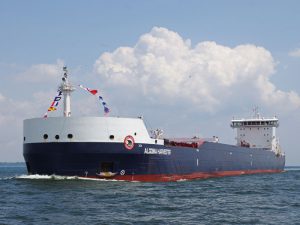
Today, Algoma said that contracts for two ships had been made effective with the delivery of refund guarantees by the shipyard, China’s Jiangsu Yangzijiang Shipbuilding Co. Ltd.
“Our search for a shipyard in China to replace the now-bankrupt Nantong Mingde Heavy Industries (“Mingde”) led us to Yangzijiang,” said Ken Bloch Soerensen, President and CEO of Algoma. “We have been pleased with the professionalism and enthusiasm the yard has shown for our project and the quality that they have shown on work done for other shipowners.”
The announcement of the two ship order at Yangzijiang follows a November 25 announcement that contracts for three Equinox newbuilds with Uljanik d.d. of Croatia had become effective with delivery by the yard of security for the contractually required construction installments.
Algoma now has five Equinox Class ships under construction at the Uljanik Group’s 3Maj shipyard in Rijeka.All the vessels will have an overall length of 225.55 metres (740 feet) and a beam of 23.77 metres (78 feet), qualifying as Seaway Max size ships. The vessels will carry 29,300 tonnes at maximum Seaway draft.
The two most recently ordered at Uljanik will feature a boom-forward configuration designed to provide greater flexibility in certain delivery situations. The others will feature a standard rear boom.
The new Equinox vessels will have all of the features of the existing Equinox design, including the exhaust gas scrubber technology pioneered by Algoma on the Great Lakes in its first Equinox Class gearless bulk carriers.
With seven ships now under construction, Algoma expects to invest approximately $450 million in this phase of its fleet renewal program. It is also reviewing its fleet plan and considering the retirement of certain older vessels.